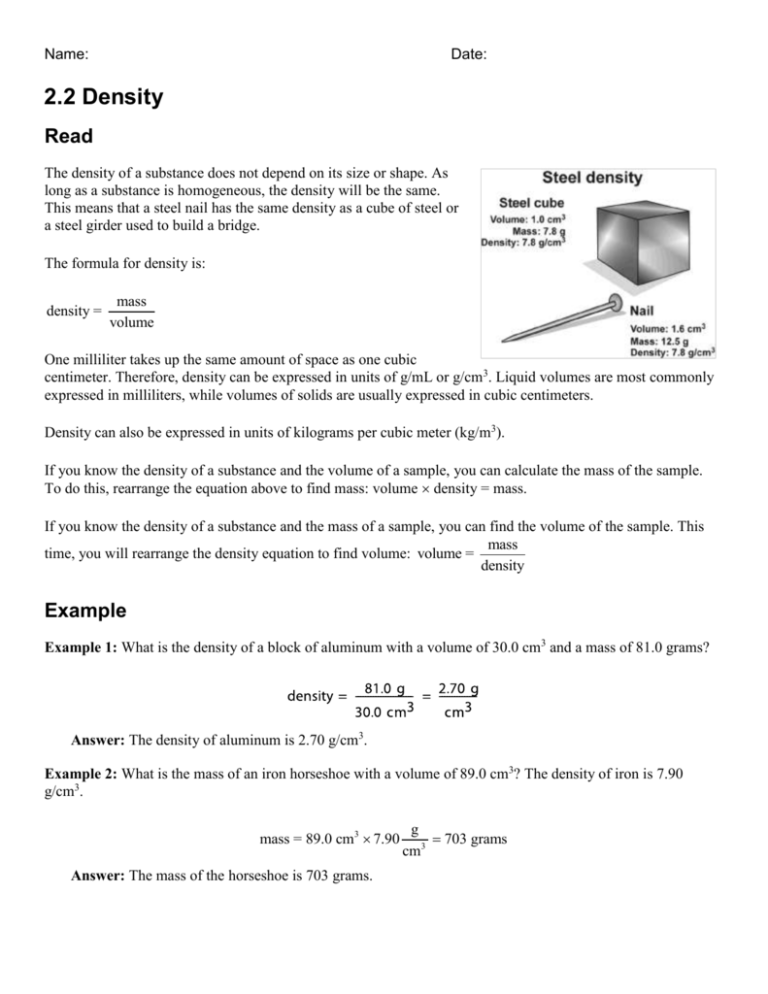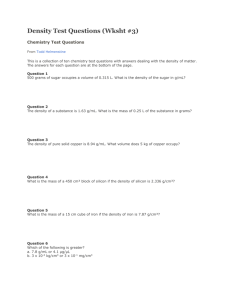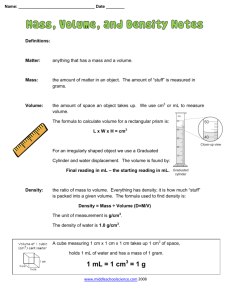Read
advertisement

Name: Date: 2.2 Density Read The density of a substance does not depend on its size or shape. As long as a substance is homogeneous, the density will be the same. This means that a steel nail has the same density as a cube of steel or a steel girder used to build a bridge. The formula for density is: density = mass volume One milliliter takes up the same amount of space as one cubic centimeter. Therefore, density can be expressed in units of g/mL or g/cm3. Liquid volumes are most commonly expressed in milliliters, while volumes of solids are usually expressed in cubic centimeters. Density can also be expressed in units of kilograms per cubic meter (kg/m3). If you know the density of a substance and the volume of a sample, you can calculate the mass of the sample. To do this, rearrange the equation above to find mass: volume density = mass. If you know the density of a substance and the mass of a sample, you can find the volume of the sample. This mass time, you will rearrange the density equation to find volume: volume = density Example Example 1: What is the density of a block of aluminum with a volume of 30.0 cm3 and a mass of 81.0 grams? Answer: The density of aluminum is 2.70 g/cm3. Example 2: What is the mass of an iron horseshoe with a volume of 89.0 cm3? The density of iron is 7.90 g/cm3. mass = 89.0 cm3 7.90 Answer: The mass of the horseshoe is 703 grams. g 703 grams cm3 2 of 3 Example 3: What is the volume of a 525-gram block of lead? The density of lead is 11.3 g/cm3. Answer: The volume of the block is 46.5 cm3. Practice Answer the following density questions. Report your answers using the correct number of significant digits. 1. A solid rubber stopper has a mass of 33.0 grams and a volume of 30.0 cm3. What is the density of rubber? 2. A chunk of paraffin (wax) has a mass of 50.4 grams and a volume of 57.9 cm3. What is its density? 3. A marble statue has a mass of 6,200 grams and a volume of 2,296 cm3. What is the density of marble? 4. The density of ice is 0.92 g/cm3. An ice sculptor orders a 1.0-m3 block of ice. What is the mass of the block? Hint: 1 m3 = 1,000,000 cm3. Give your answer in grams and kilograms. 5. What is the mass of a pure platinum disk with a volume of 113 cm3? The density of platinum is 21.4 g/cm3. Give your answer in grams and kilograms. 6. The density of seawater is 1.025 g/mL. What is the mass of 1.000 liter of seawater in grams and in kilograms? (Hint: 1 liter = 1,000 mL) 7. The density of cork is 0.24 g/cm3. What is the volume of a 288-gram piece of cork? 8. The density of gold is 19.3 g/cm3. What is the volume of a 575-gram bar of pure gold? 9. The density of mercury is 13.6 g/mL. What is the volume of a 155-gram sample of mercury? 3 of 3 10. Recycling centers use density to help sort and identify different types of plastics so that they can be properly recycled. The table below shows common types of plastics, their recycling code, and density. Use the table to solve problems 10a -d. Plastic name Common uses Recycling code Density (g/cm3) Density (kg/m3) PETE plastic soda bottles 1 1.38–1.39 1,380–1,390 HDPE milk cartons 2 0.95–0.97 950–970 PVC plumbing pipe 3 1.15–1.35 1,150–1,350 LDPE trash can liners 4 0.92–0.94 920–940 PP yogurt containers 5 0.90–0.91 900–910 PS cd “jewel cases” 6 1.05–1.07 1,050–1,070 a. A recycling center has a 0.125 m3 box filled with one type of plastic. When empty, the box had a mass of 0.755 kilograms. The full box has a mass of 120.8 kilograms. What is the density of the plastic? What type of plastic is in the box? b. A truckload of plastic soda bottles was finely shredded at a recycling center. The plastic shreds were placed into 55-liter drums. What is the mass of the plastic shreds inside one of the drums? Hint: 55 liters = 55,000 milliliters = 55,000 cm3. c. A recycling center has 100. kilograms of shredded plastic yogurt containers. What volume is needed to hold this amount of shredded plastic? How many 10.-liter (10,000 mL) containers do they need to hold all of this plastic? Hint: 1 m3 = 1,000,000 mL. d. A solid will float in a liquid if it is less dense than the liquid, and sink if it is more dense than the liquid. If the density of seawater is 1.025 g/mL, which types of plastics would definitely float in seawater?






